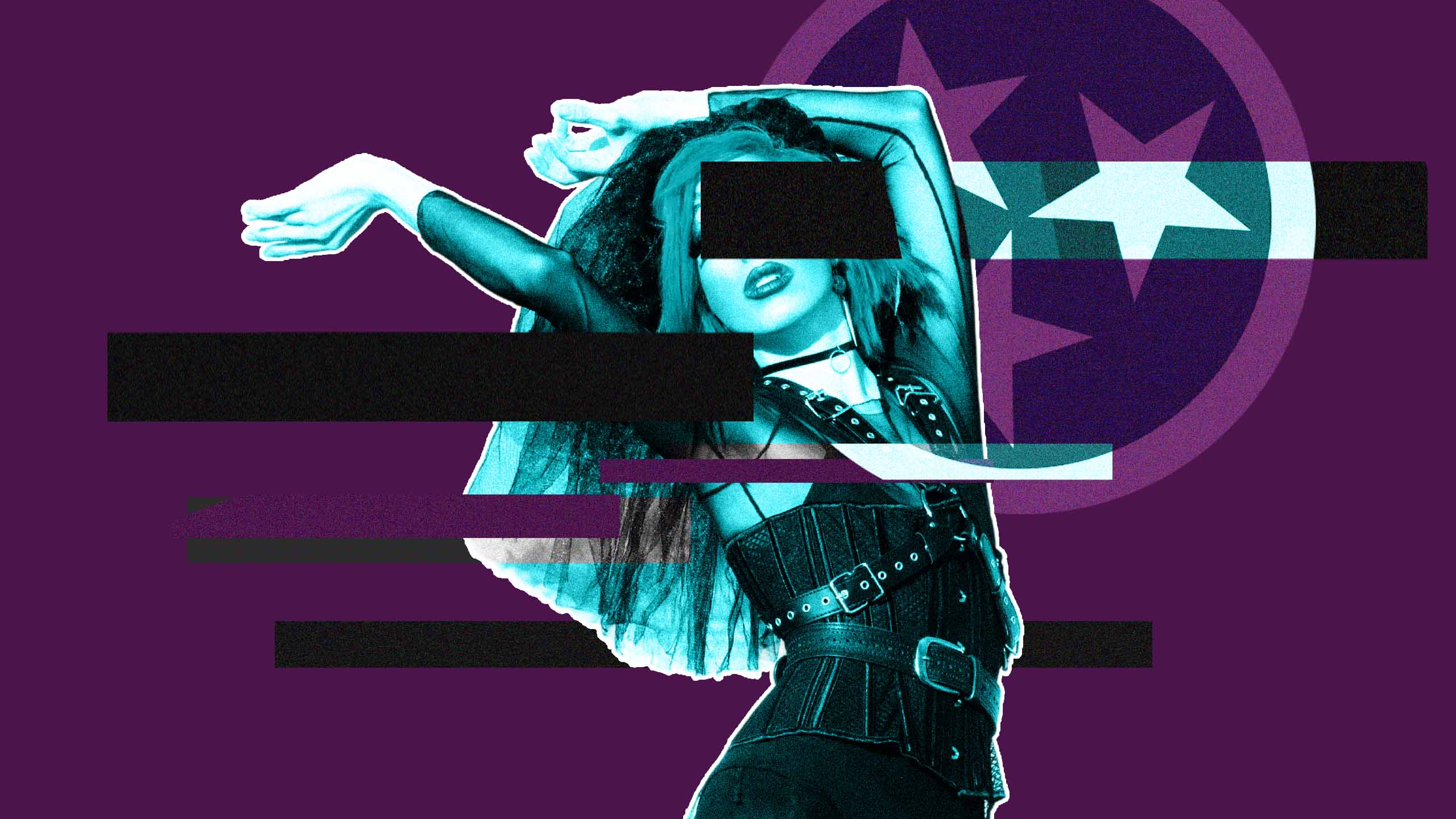All they want to do is protect the children—or so they would have us believe. A swath of bills filed in state legislatures across the U.S. propose to clamp down on public gender nonconformity. To the alarm of queer and trans activists across the country, bills framed as “drag bans” have so far appeared in Arizona, Arkansas, Missouri, Nebraska, South Carolina, Tennessee, West Virginia, Texas and Oklahoma. Sometimes the authorities want to restrict drag performers to specified locations; at other times, their scope is much murkier and potentially much wider. Tennessee’s Senate Bill 3, for example, proposes to ban “male or female impersonators who provide entertainment that appeals to a prurient interest” from performing anywhere they “could be viewed by a person who is not an adult.”
The bills’ often calculatedly vague wording could, many fear, be abused to cover not just drag performers, but all trans and gender nonconforming people. Dressing as a gender different from the one you were assigned at birth is categorized as something that children can’t be allowed to see. At its core, these bills threaten nothing less than the exclusion of trans people from public life.
Historians often warn against condemning laws like this as regressive, old-fashioned or medieval. Assuming that such views belong to the past can prop up the false idea that history is all about progress toward an enlightened future—and worse, it can erase the fact that there have always been people, however many, who’ve fought against oppression. But in this case, the fact is that the U.S.’s drag bans join a long tradition of attacks on public gender nonconformity. In their assumption that “male or female impersonators” are sexualized, and that children need to be protected from them, the bans might be responding to a very contemporary transphobic moral panic—but the ideas at their heart have a very long history.
Anti-drag laws and attempts to ban public gender nonconformity are far from new, and not confined to the U.S. Long before the police attacks on trans and gender nonconforming people that sparked the riots at Compton’s Cafeteria and the Stonewall Inn—both of which had roots in oppressive laws about gendered clothing—campaigners from England to Japan were calling for a ban on gender nonconforming performance. In late 16th-century England, as public theatre exploded in popularity, anti-theatrical writers fretted that male audience members who saw actors assigned male at birth (AMAB) playing female roles would find themselves swayed into experiencing queer attraction. Men in the audience would be completely taken in by an AMAB actor’s “female” costume, and before they knew it, they’d have what the writer John Rainolds called “wanton thoughts” about a man, and would be on their way to hell. The anti-theatricalists did believe it was immoral for AMAB actors to wear women’s clothes—for them, the bigger problem was what this might do to their innocent, assumed-heterosexual audiences.
At the same time in Japan, a similar debate was raging over the best way to prevent the theatre from stimulating sexual immorality. In 1629, authorities attempted to crack down on actors engaging in sex work by banning women and other people assigned female at birth (AFAB) from the stage. This failed spectacularly, as it turned out that audience members of all genders were quite happy to hire AMAB actors for sex instead, and the sex economy became more dominated by men and wakashu (a group of AMAB people whom Japanese society understood as neither male nor female, in part because they had sex with men). In 1642, in the hope it would make them less sexy, AMAB actors were banned from wearing women’s clothes on the stage; and ten years later, wakashu were banned from the stage entirely.
But just as the drag bans threaten to do, attacks on gender nonconformity have rarely been confined to the stage: lawmakers have also consistently tried to restrict trans and gender nonconforming people in public life. In fifteenth-century Venice, authorities barred AFAB sex workers from wearing their hair short or pulled back: as the law stated, it was feared this would “conceal their sex” and might give the sex workers’ male clients a taste for masculinity. Early 17th-century England saw a similar panic stirred up by the fashion for women and other AFAB people to wear masculine clothing—think short hair, hats, doublets, practical riding boots and—gasp—even breeches. Followers of the fashion were condemned in an anonymous pamphlet of 1620, Hic Mulier; or, the Man-Woman, as “half men, half women” and were hit with sexual slander: surely the real reason they were dressing this way was to show off their legs to men, or worse, to be able to sneak undetected into men’s bedrooms.
As European nations stepped up their colonial expansion, they exported these attitudes around the world. Gender nonconforming Native American and First Nations people, ancestors of those who now use the term Two-Spirit, were persecuted for their hairstyles and dress from the very first European invasions in the 15th century. British colonizers in 19th-century India harassed hijra populations (AMAB people who present in a feminine way and often make their living through street performance and seeking charitable alms) with the same queerphobic zeal, passing laws that forced them to cut their hair and adopt masculine clothing. In both cases, the colonizers assumed—sometimes correctly, sometimes wrongly—that AMAB people’s gender nonconformity indicated that they liked to have sex with men.
The common thread running throughout this history of oppression—and current context—is the assumption that gender nonconformity is in some way sexual. Tennessee’s lawmakers, for example, are targeting “male or female impersonators who provide entertainment that appeals to a prurient interest.” With no way to tell how they’ll determine what counts as “prurient,” there’s a very real danger that they’ll fall back on the lazy assumption that all drag performance—or, worse, every form of gender nonconformity—is automatically sexual.
As history shows us, gender nonconformity hasn’t always been associated with queer sexuality. The authorities of 17th-century England were worried that women wearing doublets and breeches were sleeping with men outside of marriage, not with other women, and their contemporaries in Japan were concerned with cutting down on sex work in general, not with policing who slept with whom. Even the anti-theatrical campaigners weren’t worried that the gender nonconforming actors themselves were queer; they were more bothered that they might spark accidental queer desire in their audiences.
In fact, in European and North American culture, the idea that drag performance was a queer thing only really became entrenched around the middle of the 20th century. For a while, the growing explicitness of sexual innuendo in the theatre had made some audiences increasingly suspicious of what might be going on between AMAB actors behind the scenes. But this was complicated in the period immediately after the First and Second World Wars by groups of ex-soldiers who toured the U.K. and U.S., performing drag shows they had developed on the front lines and in military camps. The Forces shows, bearing names like Soldiers in Skirts, combined gender nonconformity with reassuring military masculinity—and it was only after they faded from view, in a period that coincided with the increasing visibility of queer sexuality, that drag performance became as queer-coded as it remains today.
But any time authorities have stigmatized gender nonconformity as sexual—whether they’ve seen it as queer, or as leading to heterosexual immorality—they’ve been preoccupied by its potential to be dangerous. Anti-drag and “cross-dressing” laws frame gender nonconformity as something from which innocent gender conforming people need to be protected at all costs. This was true in 17th-century England, when the poet Francis Lenton described AMAB actors wearing “women’s” clothing as “tempting baits of hell,” which threatened what he saw as the innocent youth. It’s equally true in Republican legislators’ emphasis on “protecting the children.” Whether it’s banning AMAB actors from wearing female clothing to protect heterosexual audience members from accidentally finding them attractive, or banning public “impersonation” to protect children from the nebulously sexual threat it presents, campaigns against gender nonconformity position queer people and drag performers in opposition to the vulnerable groups they supposedly endanger.
The problem with this is that it leaves no space for the possibility that those queer people or performers might be members of vulnerable groups themselves. Imagining gender nonconforming people as dangerous means imagining their onlookers as innocent and unspoiled: endangered by the looming threat of queerness which, once touched, will forever contaminate them.
But the thing is: there already are queer children. Queer youth aren’t waiting to be created by exposure to drag performance: they’re already here, and they’re already vulnerable. Facing restrictions on playing sports at school and college, as well as using public toilets, trans people in the U.S.—and especially trans youth—are facing a mental health crisis. They’re far more in need of protection than the imaginary young people who might allegedly be harmed by seeing a drag queen in public.
Senate Bill 3, then, was never really about protecting those most at risk of harm. Just like the queerphobic laws of the past, what this bill is really about is maintaining existing social hierarchies and power structures. The response of many people in 17th-century England to trends in gender nonconforming fashion was to say, as gentleman gossip John Chamberlain wrote to a friend, that “the world is out of order:” women had stepped out of their proper place, upending what men saw as the natural (read: patriarchal) order of things. Likewise, the real consequences of public gender nonconformity are not that children will be harmed: it’s that children will realize they can wear what they want, and be who they want, regardless of how their body looks or what gender they were assigned at birth.
This is what liberation, for all genders, looks like. And this is what conservative lawmakers, like the centuries of oppressive authorities before them, are really afraid of.


 Why you can trust Xtra
Why you can trust Xtra


